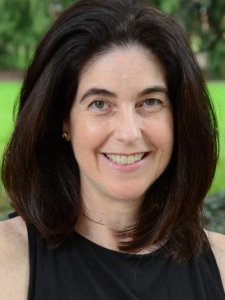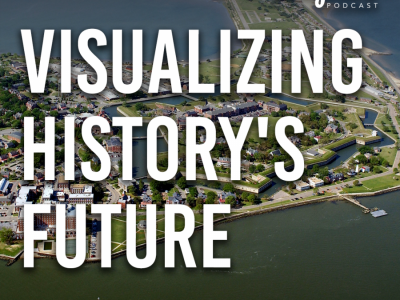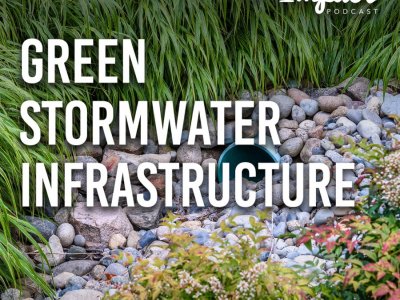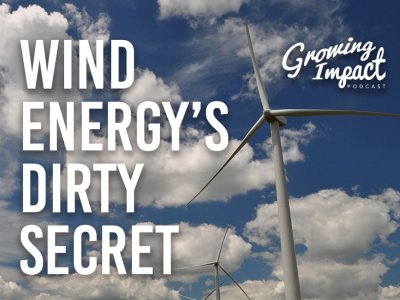In this episode of Growing Impact, Lisa Emili, an associate professor of physical geography and environmental studies at Penn State Altoona, discusses her project titled “Coastal Carbon Dynamics in a Riparian Buffer Ecosystem, Lake Erie Basin,” which is investigating carbon accumulation in freshwater wetlands around the Great Lakes area. She and her team are interested in better understanding how these wetlands fit into the carbon cycle and how these areas can help impact climate change.
Transcript
INTRO: Worldwide, coastal wetlands make up 2% of the surface of the ocean. But the carbon that is captured—that's what decreases climate warming—over 70% of the carbon in the marine environment is stored in coastal wetlands.
HOST: Welcome to Growing Impact, a podcast by the Institutes of Energy and the Environment at Penn State. Growing Impact explores cutting-edge projects of researchers and scientists who are solving some of the world's most challenging energy and environmental issues. Each project has been funded through an innovative seed grant program that is facilitated through IEE. I'm your host, Kevin Sliman. Today on Growing Impact, I speak with Lisa Emili, an associate professor of physical geography and environmental studies at Penn State Altoona. We discuss her project titled “Coastal Carbon Dynamics in a Riparian Buffer Ecosystem, Lake Erie Basin,” which is investigating carbon accumulation in freshwater wetlands around the Great Lakes area. She and her team are interested in better understanding how these wetlands fit into the carbon cycle and how these areas can help impact climate change.
HOST: Welcome to Growing Impact, Lisa.
Lisa Emili (LE): Thank you very much. I greatly appreciate the opportunity to share some information about the project I'm working on.
HOST: Can you give an overview of your project and give us a flavor of what it is that you're working on?
LE: So the group of us at Penn State that are looking at carbon accumulation in freshwater wetlands. We're distinguishing ourselves because it's an environment that is, has less known about it in terms of how it fits into the global carbon cycle, these freshwater systems. And just really looking at contemporary and new carbon accumulation and the potential for that, as well as looking at what the historical rates are because we don't even really have a good idea in these systems, at least the systems that we're working in and in the Great Lakes region, coastlines, what the actual accumulation rates are in specific areas. We have general ideas, but not something specific enough that will help us meet the challenges going forward of modeling climate change and the implications for climate change. And some of the risks that are associated with losing some of this coastal carbon in these environments.
HOST: Can we talk about coastal carbon? Can you give a little bit of explanation as to what it is and what it does?
LE: Coastal carbon really is a term that means what carbon is being stored on our coastlines. And so where is that carbon being stored? What does carbon mean? Well, carbon is in living things. So it does encompass what are the plants, what are the biota, the living things, the animals, the organisms on the surface that contain carbon. What happens if that carbon, if it's a plant material starts to decay and get incorporated into the soil? What even are the soil microorganisms that contain carbon themselves, which are still living in the soil? And then what are some of our, what we call fossil carbon, which many of us know the thing, what we burned for fossil fields. And so really coastal carbon is looking at what's being held by the vegetation, what's being held by the living organisms, and what's accumulating as decayed plant material. Worldwide, coastal wetlands make up 2% of the surface of the ocean. But the carbon that is captured—that's what decreases climate warming—over 70% of the carbon in the marine environment is stored in coastal wetlands.
HOST: Wow.
LE: I know. They're really, really small, but they pack a big bang for their buck in terms of what they can store. So understanding not just marine, coastal carbon systems, but freshwater systems is really important. So currently there's a term that's being used is called blue carbon. When they say coastal carbon now, it's referred to now as blue carbon, associated with water bodies. What really it refers to in a vast majority is marine carbon and marine coastal environments. So they're talking about the carbon that's stored in particular wetlands. So many of us know tidal marshes, think like Chesapeake Bay Area or seagrass beds or mangrove swamps. And what we're really saying with our project is, hey, wait a minute, the Great Lakes are a really large area. And I'll address that a little bit more specifically in a bit. But basically, there's a lot of coastal wetlands in the Great Lakes. And so our group is lobbying that even though it's part of a landmass and it's terrestrial, we're saying these should be considered part of the blue carbon stores. And we need to look at them as we start to think about how did they contribute on a global scale to where our carbon is being held and therefore, how could they potentially release carbon if something happens to those wetlands?
HOST: Is there any idea of how much carbon is being stored or is that part of what you're exploring in the Great Lakes?
LE: In the Great Lakes, there are estimates of the carbon being stored in the wetland systems within the Great Lakes. And so those estimates are just over nine petagrams, and a petagram is a gigaton. And so we kind of a broad picture, but we don't have a really detailed picture. And that's, that's part of where our project is going, is looking at it across some scales from the broad scale down to the really small scale at the molecular scale when we get to the chemistry part. The Great Lakes basically are the largest freshwater body and source of water, no inland water body in the world. 18% of the world's freshwater, which is mind boggling. Pretty big. They are like 14,000 kilometers of coastline. There are thousands of streams that enter into the Great Lakes. There's like 5 thousand tributaries, there's 35 million people on those shores. So huge potential. And in terms of freshwater wetlands just across the United States, not even just in the Great Lakes. There's over 350,000 square kilometers. So that's a lot of carbon like that. That's being that nine petagrams comes from that, that full across the US freshwater wetlands. And then if we think about where we are with the Great Lakes, it becomes even more important because we have so much of that 14,000 kilometers of just coastline. These systems we know are producing a lot of plants. They have a high productivity. That means they're producing a lot of carbon, more carbon than open water systems and more carbon than their dry soil counterparts in terrestrial systems. They also are capable of sequestering that carbon. So they're making more carbon. They're holding onto more carbon, which makes it even more important that you figure out what's going on with changes in the Great Lakes water levels, their hydrology, and are these wetlands threatened? In the last ten years or so, there have been record water, like record high water levels and we've seen a record increase in water levels in the Great Lakes. So it's about a 100 millimeters per year. That's one or two orders of magnitude greater than the rate of sea level rise on oceanic coasts. Most people, I think probably don't have the perception about how much the water level has risen in the Great Lakes.
HOST: What is significant about the basin and what are some challenges that it's facing?
LE: The Lake Erie Basin in particular, is the smallest and shallowest of the lakes. So there are two things that result from that. So that those rising water levels that I talked about. When we have the fetch in the Great Lakes, which is like how long something is that when the winds come across, it allows really big waves to build up. And so we have that ability them with the increased water levels, increased intense storms to push these really big waves into the coastal areas. We also see a lot of shifting of the sand along the shores there. And in the particular area that we're studying, which is in Presque Isle, which is French for “almost an island” because Presque Isle State Park is actually a spit. And so its sand has grown out from the mainland. But it's a relatively recent geologic development. So it's a really good area to look at what the more contemporary accumulation of carbon is. But it's also a very small landform that's an example of these coastal landforms that are really susceptible to these increasing intensity storms, increasing movements of sand. And those beaches are continually having to be managed as well as the impact it's having to the lagoons and the wetlands behind it. So that's something that's not necessarily unique to just Lake Erie, but the fact that Lake Erie is also the shallowest lake means it's also the warmest lake. And so when you have warmer waters, you have the potential like any kind… chemistry 101, back to high school—when you warm something up, you speed the rate of reaction. When you warm chemicals, you speed up chemical reactions. We're also breaking down those organic materials faster. And so there's the potential then to also break that organic material down and convert it to carbon dioxide. And so that's something that also makes the longevity in the lifespan, I guess I'll say, of this carbon in Lake Erie, slightly different than some of the deeper, colder lakes.
HOST: Can you talk a little bit about what you hope your projects will achieve?
LE: So for, for me, it's two-fold. I mean, I guess I would say on the broader picture, I really hope that what we find leads to helping mitigate climate change through maintaining and—so restoration and conservation of these wetlands. So that's the big picture of what we really hope to achieve. And on a smaller scale, I hope that we can help the people living in the Great Lakes area understand the importance of these systems and what can be done. Not just from a scientific standpoint, but from a human standpoint, that's relatively easy. So I think that we're working with Master Gardeners as well as the Master Watershed Stewards Program to really show people that really small changes can make a big difference in their world and their community. And so I think as a scientist who studies these kind of things that have these impacts that seem like they're global and they are. But it's also really important to bring it down to how is it really important to like even just one person's life?
HOST: How does a project like this benefit from an interdisciplinary team?
LE: You can't have a study of a cycle without having an interdisciplinary team. And so, you know, I come at this from the perspective of, I look at what's ends up gets into the water, how that water moves into the soil, and then what we're moving through the soil and out. And I would say that with our interdisciplinary team we have slightly overlapping expertise. So I do have knowledge of the type of plant materials and how that goes, but I'm not a plant person or a plant biologist. So we have a plant biologist, and she doesn't really have a complete understanding of the specific chemistry, but because she has to deal with plants, she understands the soil and how that works with the geology. But then wait a minute, this is a longer term thing that we're looking at. And what's the history of these landforms and how is this carbon accumulation? Now we have a geologist on a project. And so what you end up with this mosaic expertise. And then whenever you have that kind of mosaic and you can blend those things, what I think you end up with is a stronger picture and a stronger study because everybody brings their own expertise, but they also bring their own unique way of looking at it. And so I think we all benefit from having to, one be very clear and, two learn from different ways of doing things. So I think that is the strength of an interdisciplinary team is that together were much stronger than any one of us would be.
HOST: How about next steps or future plans? What do you see in either the near or far term?
LE: I would say like the our next steps are really leveraging as many ways of getting our information out as we can. And then understanding that it's not just natural carbon that's important to look at in these systems, but also what I'm calling anthropogenic carbon, which is like human-made carbon. So basically it's plastics. One of the things that we need to understand is how do these plastics move through this system? And does that affect how the natural carbon moves through the system? So natural carbon gets into the soil. It gets in by soil microbes which are digesting it and incorporating the soil. It also breaks down and attaches to soil sediments. And those are some of the ways that we sequester carbon. Because clays really like things. And they hold on to them. And so the organic matter and organic carbon that's attached to clays gets held in the soil for a long time. And so one of the things that we really need to find out is, do microplastics, do they fool natural carbon? So, you know, do microbes, can microbes like do they, are they going to take that carbon in the same way? Is organic matter going to attach to a piece of microplastics the same way it would attach to clay? And then the microplastics themselves like to attach to all kinds of other pollutants. Is that another issue? And so really understanding that when we say carbon now, that that carbon footprint of humans has now expanded to plastics. So for me it's really important to link those two. So understanding a now when we say carbon and when we say what's affecting our climate and our worlds, that it's both natural and what we've created. One student said to me one time, he said Dr. Emili, he says knowing what you know, he says how is it that you remain positive about the environment? And I said, well, I have to have the belief that we can figure this out. We've done this. So we need to figure this out. So as a scientist and as a mother, and as somebody who is very concerned about the world we’re leaving to future generations, I am just very hopeful that we will figure this out because we have to figure this out.
HOST: Thank you for spending time with us on Growing Impact.
LE: Thank you very much. I greatly appreciate the opportunity to speak about my research. I'm always happy to do. And I really hope that the audience, in listening to this, learned something that makes them think more deeply about climate change.
HOST: You've been listening to Growing Impact, a podcast by the Institute of Energy and the Environment at Penn State. I’ve been your host, Kevin Sliman. This has been season two episode three. Thank you for listening.








